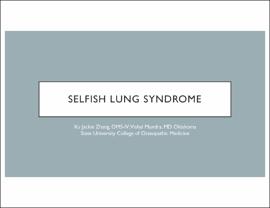| dc.description.abstract | Introduction: Congenital lobar emphysema (CLE) is a rare congenital developmental anomaly that is characterized by hyperinflation of one or more pulmonary lobes. Although the exact etiology of the disease is unknown, the most frequently identified cause is obstruction of the developing airway. Airway obstruction can be intrinsic or extrinsic, with the former being more common. An example of intrinsic obstruction occurs when there is bronchomalacia or absent cartilage, that creates hyperinflation. As a result, compression atelectasis occurs to the surrounding area and can result in ventilation perfusion mismatch. The left upper lobe is the most affected, as seen in 40% to 50% of cases. This disorder has a prevalence of one out of every 20000/30000 with higher incidence in males. Patients are often diagnosed and treated in the neonatal/infant period but some cases can have a more gradual and insidious onset that require treatment years later.
Case: A 55 year old male, with a hx of CLE and tobacco abuse, came to the ED with dyspnea and cough. He was in mild distress, tachypneic, and oxygen saturations were in the 70s. He had a barrel-shaped chest wall and some expiratory wheezes were noted as well. He was not on oxygen at home and did not follow up with a pulmonologist. Pt denied having any surgical intervention for his congenital malformation other than bronchoscopy as a child. CT chest with contrast showed massive bullous emphysema on the left with mass effect on the right lung and deviation of the anterior junction line by approximately 8 cm to the right. Additionally, there were airspace opacities within the left lower lobe with fluid/fluid level within some of the left-sided bullae, raising the possibility of pneumonia. He was started on Zosyn and recovered well. Cardiothoracic surgical team was consulted and they recommended left pneumonectomy. However, the patient wanted to pursue the surgery outpatient. At the time of discharge, he was hemodynamically stable, saturating above 90%, and returned to baseline. Unfortunately, he was lost to follow up.
Discussion: This case illustrates that even though the patient was mostly asymptomatic throughout his life, his lungs continued to deteriorate. It may have started in one lobe of the left lung but slowly progressed to involving the entirety of the left lung. It is essential to reinforce in patients the importance of continuous monitoring and follow up regardless of symptom status. | en_US |

